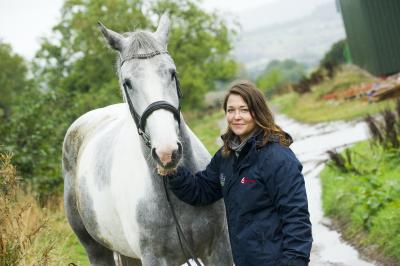
By vet Selina Squarotti
Sarcoids are the most common skin cancer of horses and they do not seem to have breed, age and sex predisposition.
Research on the causes of these tumours is ongoing but they seem to be linked to a Bovine Papilloma Virus (BPV), which causes sarcoids in genetically susceptible horses. This means that not every horse exposed to the virus will develop sarcoids, but those genetically susceptible, might get them again after treatment, since the susceptibility remains.

The ability of sarcoids to transmit by horse-to-horse contact or spread by flies is unproven. But there is increasing evidence suggesting that susceptible horses grazing with horses with sarcoids are likely to develop them as well.
Sarcoids are usually locally aggressive and they vary enormously in appearance and behaviour. It is important to identify the type of sarcoid because inappropriate treatment can make sarcoids more aggressive.
The main types of sarcoids are:
Occult: Frequently found on the groin or the head. Usually slow growing and can easily be mistaken with rub marks and ringworm.
Verrucose: Frequently found on the head, axilla or inner thighs. They have a warty, flat, dry and scaly appearance. They are usually slow growing and can be confused with ringworm, scarring or skin overgrowth following trauma.
Nodular: Well demarcated lumps, which can either be mobile under the skin or firmly attached. Usually located in the armpit, inner thigh, groin or eyelid. Medium growth rate and might change behaviour over time.
Fibroblastic: More aggressive and can be found on limbs, wounds and joints and can be life-threatening. They can have an ulcerated fleshy appearance, can grow rapidly and can invade the tissue underneath the skin. Early treatment is crucial to avoid a rapid development of an unmanageable ulcerated sarcoid during fly season.
Mixed: These are a combination of the types above. It is quite common for horses to develop sarcoids of different types either in the same location or in different parts of the body.
Malignant: Fortunately not that common. This type is very aggressive and can spread from the original site via lymphatic vessels.
Due to the high rate of recurrence and different behaviour of sarcoids, these tumours are difficult to treat. There is no optimal treatment so many different treatments are being proposed.
Medical treatments include the topical chemotherapy cream AW4-LUDES (Liverpool cream) which causes skin necrosis and scarring; the immune stimulant BCG vaccine injected directly in the tumour, usually only used for periocular sarcoids; injectable chemotherapy drugs cisplatin and Mitomycin C or various topical creams such as acyclovir, imiquimod and others.
Ligation or banding of a sarcoid can be tempting, but before this is attempted, the veterinarian needs to check if the sarcoid has a root extending into deeper tissue or it could be extremely dangerous to the horse. Ligation is more successful if combined with topical treatment to kill the root of the superficial tumour.
Surgical treatments include surgical excision with smart surgery, as sarcoids tend to invade the sutures and re-grow locally on the surgical wound with standard surgical excision, cryosurgery (freezing) and laser surgery. Because of the rate of recurrence surgical treatments can be coupled with injectable chemotherapy drugs in the surgical site following the surgery.
Other options are electrochemotherapy, involving a combination of the injectable chemotherapy drug cisplatin in the tumour followed with high-voltage electric pulses under a brief general anaesthetic and radiation therapy, involving the placement of radioactive material in or around the sarcoid.
To conclude, sarcoids are a form of cancer and should be treated with respect. Applying anything on sarcoids without seeking expert advice could be very dangerous and detrimental for the horse, potentially decreasing the success rate of any future treatment.